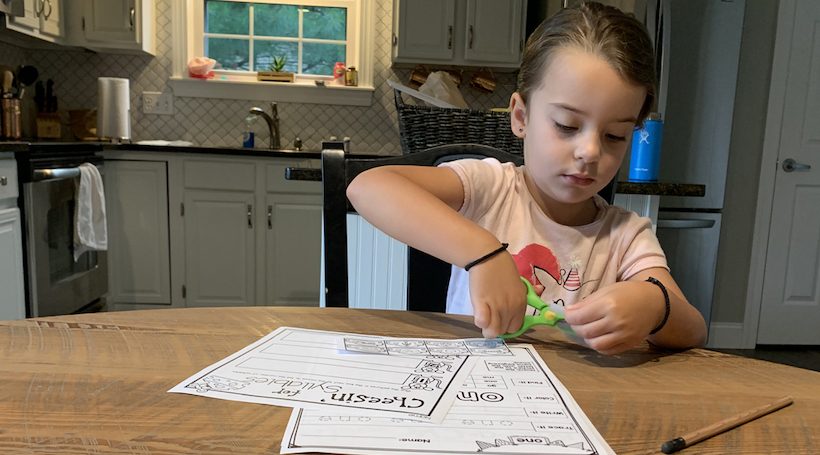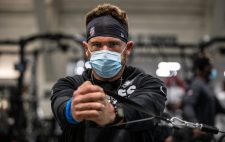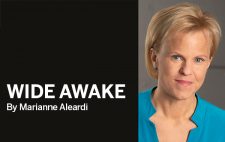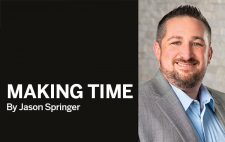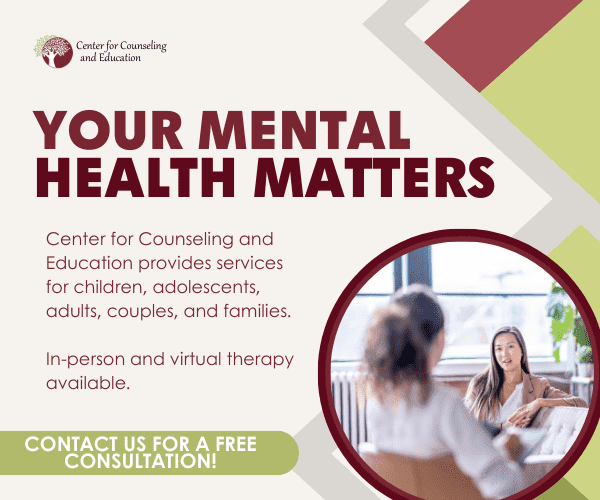Amid all the changes Covid has brought into our everyday lives, there is one area that still seems to have everyone baffled: How do we get kids back to school? It’s a question that has been stressing out parents, worrying teachers and testing school boards for months. Everyone agreed they wanted a safe environment where kids can learn. They just couldn’t agree on how to make that happen. Even as kids return to learning, no one knows for sure if they figured it out.
A few weeks into the quarantine, Jaime Austino developed a mantra to keep herself going. The Voorhees mom of 2 was struggling.
“I’d wake up at 5:30 with my 7-year-old to start her schoolwork first thing in the morning, because it took her so, so long, and I’d put my 4-year-old in front of the TV for the day,” Austino says. “This went on for weeks and weeks. I just kept saying to myself, ‘I’ll be ok as soon as we go back to school.’ Then it was like, ‘I’ll be ok as long as there’s summer camp.’ Then there was a shift a couple of months ago to, ‘As long as there’s school in September, I’ll be ok.’”
But as the pandemic dragged on, South Jersey students and their families were faced with an uncertain future. Parents had to decide whether their children would return to classrooms in person, take classes online or do a hybrid of the two. Some considered homeschooling or explored a new concept called “pandemic pods,” where families split the cost of a teacher to instruct their kids at one of their homes. Most schools couldn’t or wouldn’t accommodate their full student body 5 days a week, proposing split schedules that were daunting for working parents like Austino. The question of what school – and her family’s life – would look like in the fall had her overwhelmed.
“If you have 2 parents who physically have to go to work, what are you supposed to do?” she asks.
Austino is a nurse who works in biotech. Her husband is a police officer. “I’ve left my house a few times to go to work, but I can count on one hand the number of times I’ve left my children since March,” she says. “It’s very nice leaving for work, but the nightmare is still waiting for you when you get home.”
An uncertain future
That nightmare of stress and anxiety is tied to a deep sense of uncertainty, says Sheryl Berardinelli, senior neuropsychologist at Bancroft NeuroRehab. “There’s anxiety related to whether their kid will get sick or get exposed, anxiety about juggling family and work responsibilities. They’re anxious about the quality of their kids’ education and the social aspect of how this will impact their children.”
With the situation and options in constant flux, it’s nearly impossible for a parent to stop worrying or to know for sure if they made the right decision, Berardinelli adds, but the more informed and carefully considered a choice was, the better they should feel.
“It’s possible to feel good about the decision-making process if they know they considered the different risks and benefits while making those decisions,” she says.
For Austino, the decision of whether or not to send her 2 daughters, now a third grader and a kindergartener, back to in-person school was a difficult one. She wants to know her children are safe, but she also knows they don’t want to be stuck at home any more than she does.
“My kids cried that they miss their friends,” she says. “This has been devastating for them. I’m doing everything in my power to give them some normalcy back, but nothing is normal.”
As much anxiety as parents are facing, kids are feeling the strain too, says Berardinelli. “If they’re more withdrawn, fighting more with siblings, seeking more reassurances or seeming more moody, those are signs the child is anxious,” she says. And not necessarily about the pandemic. At least, not directly. “They’re aware of the virus, but for some kids they’re more anxious about normal school stuff. Will I be in the same cohort as my friends? How much work will I get? Will I be able to catch up?”
The best way to alleviate kids’ anxiety throughout the school year, she continues, is to have open conversations, encourage them to express their feelings, and “validate and normalize anxiety.” For parents, the best treatment for anxiety caused by the new school environment and the uncertainty of the future is simple and, she acknowledges, perhaps easier said than done: have a plan.
“Make informed choices,” Berardinelli says, “not just asking the other moms, ‘What are you guys doing?’ and going along with the consensus, but really making informed choices based on your family’s needs.”
Austino made plans and backup plans and considered every possibility. She put her third grader on the waiting list for a private school but knew the likelihood of them being able to accommodate her was low.
“I thought about pulling her out and homeschooling her, but I have to leave my house to work,” she says. For now, the plan is public school: 2 half-days in person and 3 days at home. “My husband’s going to have to take time off now. We have to spread out how we manage this. He’s going to have to help out more, and he’s the captain of a police department.”
As for her kindergartener, Austino’s enrolled her in a private school. “They’ve said the kids can go, in person, 5 days a week,” she says. “It’s going to cost us probably $15,000 for the year, but it’s either I do it or I lose my job because I can’t work. She’s little and she requires a lot of attention, and right now I’d spend any amount of money to send my kid to school.”
What will school be like for you? (Parents)
Without question, we chose 100 percent remote. Our district tried, but we don’t believe they are able to do enough to ensure safety for the staff, students and their families.
Missy Wayne, Cherry HillRight now it’s 2 days at school for 4 hours and 2 days remote. And I reserve my right to change my mind as the situation changes. I’m playing it by ear.
Marla Feldman, MarltonI’m trying so hard to balance my daughter’s physical health with her emotional health. None of the available options really did this, but we made the most of it and did the best we could.
Rachel Lippoff, Cherry HillMy vote is a gap year until they can go back fulltime as usual. What could they learn remote?
Tricia Condurso, BellmawrMine is doing both in-school and virtual. I chose this option based on a conversation
I had with my son. He prefers in-person because he likes connecting one-on-one with his teachers, especially if there is something he doesn’t understand.
Jackie Campbell, PennsaukenI really didn’t feel completely comfortable with my high school senior going back to school this year, but we allowed it because she will only be there physically 2 days a week. If it was anything but her senior year, we probably would have opted for fully remote. If she wasn’t able to drive herself, we definitely wouldn’t have let her
take the bus.
Melissa Miller, VoorheesWe chose hybrid. It’s only 2 half-days a week. It actually stinks…I thought they should go every day even if it’s a half-day. Teens need socialization. At least if they are in school, they have to follow social distancing and other rules. Do parents actually believe teens will stay in all day and away from friends? Nope.
Kim Aydelotte, CollingswoodWe chose fulltime, 5 days a week for my son. He goes to a smaller Catholic school where they are able to make arrangements to socially distance the children. They have barriers between the desks and rules about wearing masks. Yes, it worried me to send him back; however, I know that my son’s teachers and school are doing the best they can with what they have been given.
Christina Oswald, Audubon
A system of support
While it didn’t make her situation any less fraught, Austino says she recognizes that she’s fortunate to have the resources to hire childcare help and private tutors, group with other parents in a pandemic pod or pay private school tuition. That’s not the case in other towns across South Jersey, says Jonathan Cetel, director of external affairs at the nonprofit Camden Education Fund.
“In other communities there are tutors, supplemental services, enrichment experiences,” he says. “That’s not something we can depend on in Camden. We need the school system to deliver the high-quality education our students deserve.”
In the spring, the Camden Education Fund worked with schools and local corporations to quickly purchase $400,000 worth of laptops to ensure the city’s students could stay connected. The next order of business was helping schools develop plans to get those same students – and their teachers – online.
“Summer vacation immediately shifted to planning what the fall was going to look like,” Cetel says. “A lot of our work is grounded in the idea that teaching is a challenging exercise in the best of circumstances. Now, they’ve been asked to entirely shift the way they think about what good instruction looks like. They’ll need resources to feel safe and supported. It was obvious there would be additional costs as schools started to look at reopening.”
To help, the fund distributed $800,000 across the Camden public school district, plus 3 Renaissance schools and 4 charter school networks, to cover costs that range from new learning software systems and personal protection equipment to the salaries of newly hired school social workers.
In August, it was announced that the district would begin the year with full-time virtual instruction, but as schools’ needs continue to change and evolve, Cetel says, the nonprofit and its community partners will be right there to offer aid and assistance.
“Learning will happen this fall,” he says. “We’re supporting schools in every way possible to make that happen.”
What will school be like for you? (Kids)
Between the choice of 5 days in school or remote only, I chose all day. As a volleyball player, it was important for me to play – and also see my friends. The school’s policy is that if you’re not in school you cannot be involved in sports. Another reason is my school routine is really important to me. Being online last year I felt like I didn’t get the same out of school as when I was in the classroom.
Sadie Portnoy, 16
Paul VI High School, HaddonfieldMy mother and I decided it would be best if I stayed online. My mother and brother have stuff that could make the virus more deadly to them. Also last year I did significantly better and learned more at home than at school because it helps with my short attention span.
Aaron Beltra, 15
Cherry Hill EastI really wanted to go back to school, so I’m doing hybrid: 2 days in school, 3 days online. I’m not too worried about me getting the virus, but I am worried about bringing it home to my mom. I know school is taking precautions though, and I will shower and change my clothes when I come home. So I think we’ll be ok.
Ashley Butts, 16
Collingswood High SchoolI’m going fully remote because I was concerned that there is no air circulation in school. I’d rather protect my family than barely see my friends.
Raquel Sloves, 15
Eastern High School, VoorheesMy school is doing everything in 6-week increments, so I’m trying out remote learning
to start. It was a hard decision because I want to see my friends, but we’re going to see how it goes. I’d rather be in class, though, because you get that one-on-one time with your teachers.
Shaan Doshi, 14
Moorestown Friends SchoolI’m going back 5 days a week. My school has a lot of space in the rooms, and we all have our own desks, so I’m not worried. I don’t like wearing a mask and face shield because I’ll be sweating. But we get at least an hour of outdoor time each day, even if it’s raining. I like that.
Ben Maley, 12
Christ the King Regional School, HaddonfieldI chose full-day school. I’ll be a freshman, and I want to meet new people, make new friends. You can’t really do that on a zoom call.
Carly Troy, 14
Bishop Eustace Preparatory School, Pennsauken
A community cornerstone
Julia de le Torre, head of school at Moorestown Friends School (MFS), wanted nothing more than to provide her faculty, parents and students with clarity about the new school year, but she knew much was out of the school’s control.
“Everyone is going to lose something this year,” she says. “We tried to figure out the best way to support families and faculty and staff to provide the best learning experience we can given the situation. We tried to pick the best possible solution from a list of unappealing solutions. It isn’t what school should be, but it’s what school is.”
For now, MFS has planned an orientation period in which instruction will be delivered both in person and remotely to reduce the number of people on campus at the same time as they’re adjusting to very different procedures, processes and physical spaces. By late September, it is expected to shift to 5-day, in-person instruction. There’s also the option for students to attend online school only.
“The option that was taken off the table was everyone in person every day,” de le Torre says. “We hope to return to that at some point, but we don’t think it’s an option this year. Our goal wasn’t just to open but to stay open, and that meant taking the long view in a rapidly changing situation.”
The administrator says teachers began developing innovative ways to help all kids learn – and flourish – despite a non-traditional environment. “Learning doesn’t have to happen in 45-minute chunks or inside the 4 walls of a classroom,” she says. In fact, she’s hopeful that the challenging situation will force education to change for the better, toward increased access and individualized instruction.
“There’s a lot we can and should learn from this moment,” she says. “We shouldn’t squander it. Nobody asked for it, but if we come out the other side and we haven’t changed the way we do things, we’ll have wasted an opportunity.”
The rest of the world can come to a stop, de le Torre adds, but learning never does. And while it’s an unprecedented time for parents, kids and school communities, there’s truly never been a more teachable moment.
“It’s prompted us to understand the fragility of life and the planet and our dependence on one another,” de la Torre says. “I think if schools don’t tap into the questions of why we exist and what we mean to one another, and how we make the world better and greet challenge, we’re missing the point of school. The world needs schools more than ever right now. So…here we go.”


